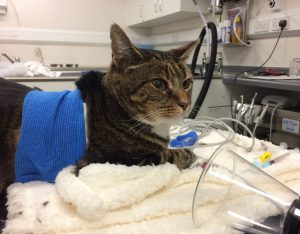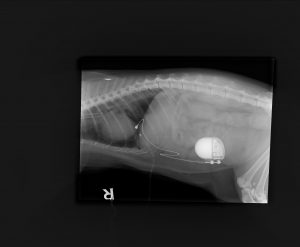Betty’s facelift
Meet Betty the lovely Bassett Hound. Betty is 3 years of age and as you can see from the photog..
+ Read moreShady had become quite lethargic despite only being a middle aged puss cat. A thorough examination at the Walker Green Veterinary Surgery in Altrincham identified that Shady had a very slow heart rate of 80 beats per minute. Cats would normally be expected to have a rate of 160-200 beats per minute. Emily Dutton, a specialist cardiologist from Cheshire Cardiology performed an echocardiogram of Shady’s heart which revealed that he was in 3rd degree heart block. This is a severe condition in which impulses from the normal pacemaker of the heart are blocked from passing to the ventricles in the bottom half of the heart.
Shady’s best chance of survival was to have an artificial pacemaker fitted. In cats and small dogs, the pacing lead is often to wide to be passed via the blood vessels, so surgery is performed to place the pacing lead directly onto the outside of the heart muscle – the epicardium, via an approach through the diaphragm.The small pacemaker unit is then made a new home within a pocket created in the abdominal wall out of harms way.Any residual air in the chest is carefully removed by a catheter before Shady wakes up.
During this type of procedure it is of paramount importance that there is not only an experienced surgeon, but also a specialist anaesthetist Carl Bradbrook of Ace Vets, Emily Dutton present throughout to set up the pacemaker and a vigilant nursing team. Shady made an excellent recovery, has more energy , is more playful and his heart is now capable of beating at 130 beats / minute, up to 185 beats / minute when he is feeling very energetic.

